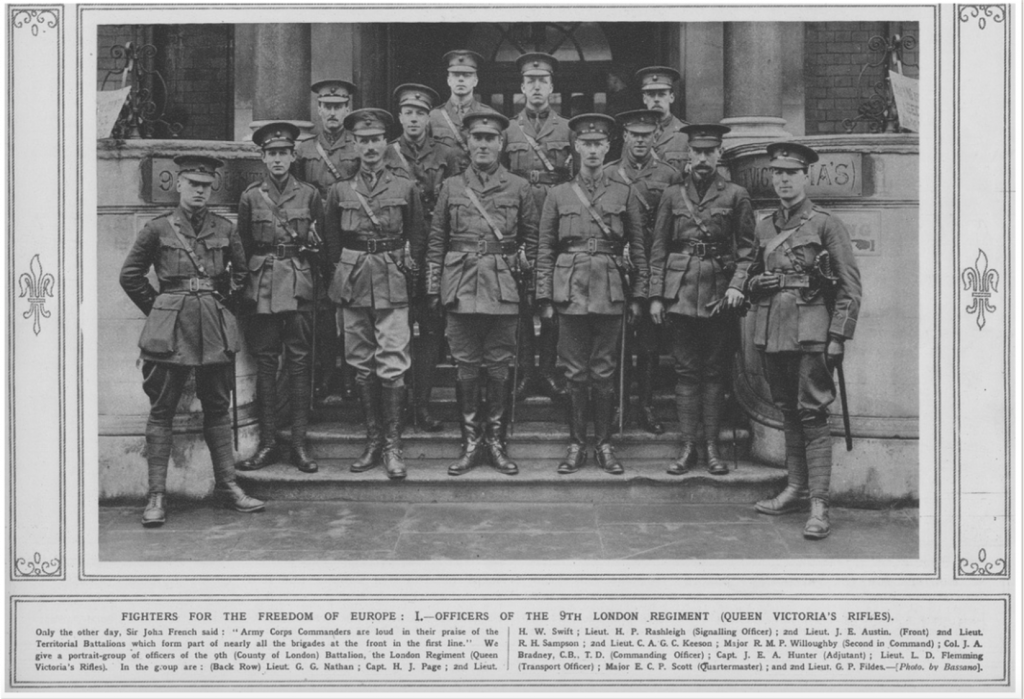
Lt Col Cuthbert Alfred Garnet Cuthbert Keeson OBE MC TD served in the Regiment during the Great War, being gazetted on St Valentines Day 1915 and rising to the rank of Captain and winning an MC in September 1918. The citation reads:
“For conspicuous gallantry and devotion to duty, This officer led his company to the final objective with great dash, and although his left flank was exposed and the enemy behind him, he quickly grasped the situation and taking command of all the troops in the area, he consolidated and held the position. By the decisive manner in which he handled his men he was responsible for the capture of fifty prisoners and some machine guns. His clear and accurate reports on the situation were of great value.”
His early experiences of the war were highlighted in a letter to his alma mater, printed in the Hurst Johnian of 1915:
“I have had charge of a post. There was a dug-out, the bottom of which was flooded, and three steps leading to it, which formed our only corer. I shared with a sergeant a hole 2ft. 2in. either way, and in this we had to do our cooking, while we were shelled like anything.
Last night I was coming out in utter darkness, when I suddenly sunk in thick and sticky mud. The more I struggled the more I sunk. I went in up to my thighs, and couldn’t move, but a man came along just in time, or I should have been drowned. Even so it took half-an-hour to got me out, and when I was free I could hardly stand. I was covered in mud from head to foot, and in my struggles my hands were coated thick with mire, so that wher I scraped them I found my ring was gone. Though I felt too weak to do anything yet, I had to do a six- mile walk along duckboards, winding in and out of shell-holes, and to-day I am none the worse.”
He was wounded on 10 August 1918 “in the push before Amiens, and has three holes in his back”. He was sent back to hospital in Brighton and recovered.
He became Commanding Officer of the Queen Victoria Rifles from 1934 to 1938.
The Second World War saw him serving on the Staff as a Brigade Major for 71st Infantry Bde, being made an OBE and earning the TD.
He is shown second from the left in the group photograph above, along with fellow Lodge members Maj James Hunter (Adjutant, to the right of the CO) and Quartermaster Major Scott. The officers are from the Reserve Battalion.
Initiated in 1919, he progressed through the Lodge’s offices, becoming Worshipful Master in 1925. He was then appointed DC of the Lodge through to 1946, allowing for the closed years during the war. He was known as an excellent ritualist, given LGR in the sixties, and was a keen proponent of the Royal Arch, being a member of St Albans Chapter No 29, along with Dickins, E W Cox, R W Cox, and J E A Hunter and so many others that the Chapter became the defacto Chapter for the Lodge.
He was the Founding ADC of his old school Lodge the Hurst Johnian Lodge No 4937.
He wrote the Regimental History, relying in part on Dickins‘ diaries from the Great War.
Keeson’s father was Charles Alfred Cuthbert Keeson, a member of both the Lodge and the Regiment, Master in 1898 and 1915, DC and LGR like his son.
Keeson went to Hurstpierpoint like his father before him, and like him became Secretary of the Hurst Johnian Club.
He was also a keen fencer, particularly in the Epee. In 1928 his success in competition was reported in the Sunday Times:
“The result of the pool furnished a mild surprise, Capt. C. A. Keeson emerging successful with a full quota of victories. This was unexpected, inasmuch as the winner—an 4p4eist of quite considerable experience—has for a long time failed to maintain the very promising form he displayed in the early stages of his fencing career. On yesterday’s per- formance, however, there is no little evidence to show that he may yet fulfil that promise. The victor played a careful and orthodox game, and I was pleased to note that the majority of his bouts ended in characteristic duelling fashion with the hit at the sword-arm.
By the end of the second round Count Lavradio, Lieut. Cederin, and Captain Keeson were clear of their rivals, undefeated. The last-named two came together in the next series, and Capt. Keeson narrowed the issue by beating the Swedish exponent by an excellent ” double “, which landed on the upper surface of the sword-arm. Lieut. Cederin subsequently struck a bad patch with two further defeats by H. Foss and Count Lavradio respectively. The undefeated leaders continued their winning careers through the next two rounds, and thus their meeting, which occurred in the last stanza, was the vital moment. Herein after cautious sparring Capt. Keeson launched an attack which arrived on the body. His opponent made a vain attempt to time the movement, but his point landed fiat on the shoulder.“
He died in 1968.